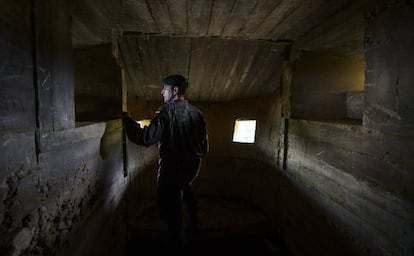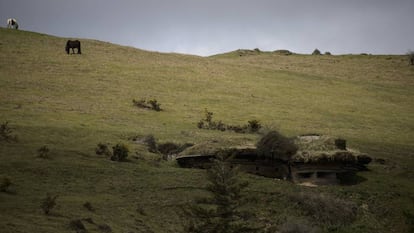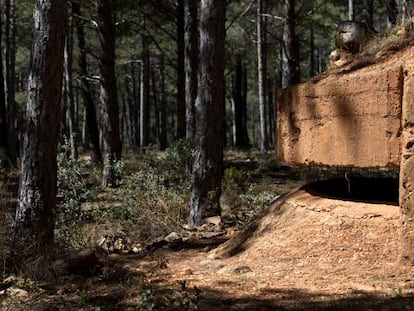The network of 6,000 bunkers that Franco built but never used
In fear of post-war invasion and internal resistance, the Spanish dictator ordered his own version of the Maginot Line to be constructed in the Pyrenees


From the top of the Otxondo mountain pass, in the north of Navarre, you can see France just 10 kilometers away. A cellphone message confirms that the device is now connected to a telephone network in Spain’s neighbor to the north. Hidden in this picture-postcard area of the Pyrenees is a little-known chapter in the recent military history of Spain. It’s called the P Line, a network of around 6,000 defensive fortifications that former Spanish dictator Francisco Franco ordered built in the 1940s and 1950s, for fear of a post-Civil War foreign invasion and to defend against domestic resistance. But the installations, which stretched from the Basque province of Guipúzcoa to Catalonia, never had to be used.
The concrete structures, some of which were hand-carved into rock or camouflaged on top of a hill, are impressive for those who dare enter. The majority are not particularly large, but big enough to hold between five and 30 soldiers, who would be able to fight off a hypothetical attack using artillery or rifles.
This was the response by the regime to its international isolation and the fear of a possible invasion by the allied democracies
Historian Diego Gaspar
Others are even more impressive due to their dimensions and design. One is barely visible to passing drivers, as it is hidden inside the mountain. It’s a two-floored construction, like a duplex, joined by 42 steps and with a large amount of space for bunk beds.
“This is the only one of this style in Navarre,” explains Sergeant Quirós, who is serving as our guide to these narrow, dark and muddy tunnels. His regiment, América 66, has catalogued more than 200 of these fortresses in the last three years.
Slightly higher up, near the Camino de Santiago pilgrimage route, there is another bunker that has three entrance points and two corridors measuring more than 50 meters long. “In summer it’s impossible to be here because of the mosquitoes,” explains the sergeant. Nearby is the jewel in the crown of the area, a 150-meter installation with several lateral passageways that were carved out of the rock by hand.

“This was the regime’s response to its international isolation and the fear of a possible invasion by the allied democracies,” explains the historian Diego Gaspar. “In fact, anti-Francoist elements had already entered, in particular in the Arán Valley.”
Planning for the network began in 1939 under the official name of the “Defensive Organization of the Pyrenean Border.” The majority of the work began in 1943 and lasted for 15 years, until Spain emerged from its isolation and Franco was no longer afraid of an external attack. A decade before, France had created its equivalent defenses, known as the Maginot Line, to protect itself from Italy and Germany.
Despite the passage of time, the majority of the fortresses have lasted more than 50 years with barely any damage
Franco had planned around 10,000 fortresses along the 500-kilometer border with France, although in the end around 6,000 were finally built. The exact number is unknown given that many are now hidden among the vegetation. They were never put to use, given that the feared invasion never took place, but the military plan stayed active well into Spain’s democratic period. “Until the end of the 1980s it was a taboo subject on a military level,” explains a spokesperson from América 66.
Thousands of soldiers were charged with building the network, along with some prisoners too. But given that the project was secret, the latter were relegated to auxiliary roles, such as constructing access roads. The working conditions were particularly tough in winter. “They brought us Fiat trucks from the war in Ethiopia, but they would freeze, so to start them up we would sometimes have to light a bonfire under them,” explained one of the soldiers who worked there in 1945, Manuel Esteban, in the book When Franco Fortified the Pyrenees, written by José Manuel Clúa, who is an expert in the P Line and the creator of three tourist trails in Aragón.
The base of operations for the network was in the Canfranc train station, to which the building materials would be sent and where the workers would sleep. Workers would be sent out to the “nests,” as the fortifications were called, in vehicles and then complete the journey by mule or on foot. “Some of the installations were hard to reach,” explains another soldier in the book. “There was only time to do one trip a day, which gives you an idea of the distance you had to travel, and on many occasions up a very steep incline.”
Despite the passage of time, the majority of the fortresses have lasted more than 50 years with barely any damage to them. “If we had to use them in the interest of national defense, we would take about an hour to clean them up and occupy them,” explains Sergeant Quirós.
But despite the cost of the project, the thousands of men needed to construct the network, and efforts to keep it all secret, it was never used for anything effective – at least, not for what it was built for. With the passing of time, locals have found new uses for the bunkers, turning them into stables or even a storeroom for funeral urns.
English version by Simon Hunter.
Tu suscripción se está usando en otro dispositivo
¿Quieres añadir otro usuario a tu suscripción?
Si continúas leyendo en este dispositivo, no se podrá leer en el otro.
FlechaTu suscripción se está usando en otro dispositivo y solo puedes acceder a EL PAÍS desde un dispositivo a la vez.
Si quieres compartir tu cuenta, cambia tu suscripción a la modalidad Premium, así podrás añadir otro usuario. Cada uno accederá con su propia cuenta de email, lo que os permitirá personalizar vuestra experiencia en EL PAÍS.
¿Tienes una suscripción de empresa? Accede aquí para contratar más cuentas.
En el caso de no saber quién está usando tu cuenta, te recomendamos cambiar tu contraseña aquí.
Si decides continuar compartiendo tu cuenta, este mensaje se mostrará en tu dispositivo y en el de la otra persona que está usando tu cuenta de forma indefinida, afectando a tu experiencia de lectura. Puedes consultar aquí los términos y condiciones de la suscripción digital.
More information
Archived In
Últimas noticias
Reinhard Genzel, Nobel laureate in physics: ‘One-minute videos will never give you the truth’
Pinochet’s victims grapple with José Antonio Kast’s rise in Chile
How Japan is trying to avert ‘digital defeat’
The complicated life of Francesca Albanese: A rising figure in Italy but barred from every bank by Trump’s sanctions
Most viewed
- Pablo Escobar’s hippos: A serious environmental problem, 40 years on
- Why we lost the habit of sleeping in two segments and how that changed our sense of time
- Trump’s obsession with putting his name on everything is unprecedented in the United States
- Charles Dubouloz, mountaineering star, retires at 36 with a farewell tour inspired by Walter Bonatti
- The Florida Keys tourist paradise is besieged by immigration agents: ‘We’ve never seen anything like this’










































